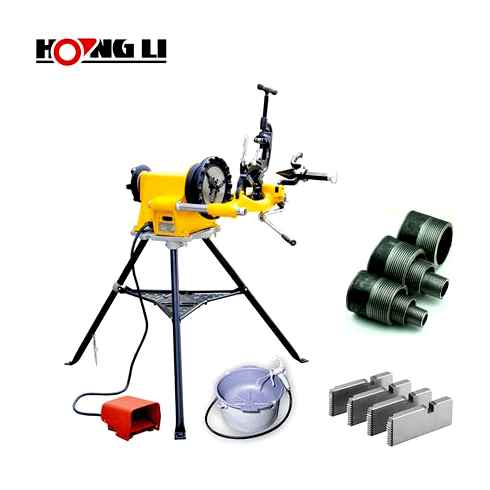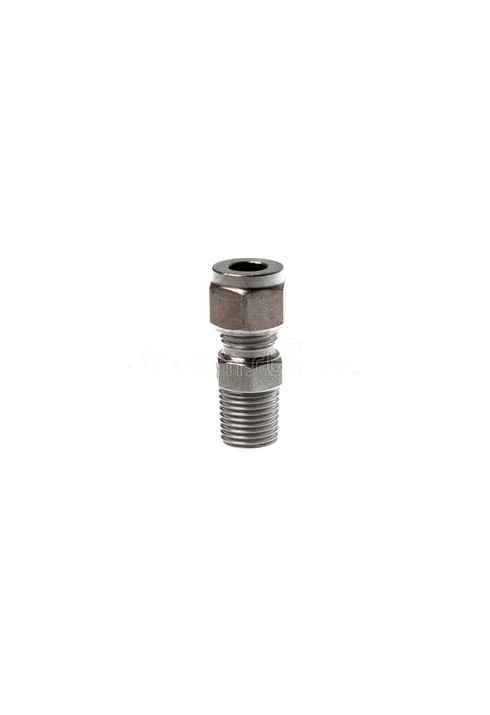How to thread a metal pipe
Instructions for tapping with a die
Cutter is a metal disc with a round petal hole in the center. Blades have cutting edges that cut threads of a specific size and shape. Dies are made of metal with a higher hardness than the pipe material. It is high speed steel or alloy steel.

- Preparing pipe. Cleaning off dirt, degreasing surface.
- Clamping in a vise. When working on the location of the pipe a gas wrench is used.
- Removal of the end chamfer. The cut of the pipe must be made at a right angle to its axis. Remove the chamfer with a wheel or file.
- The place of cutting is lubricated with technical oil.
- Cutter is inserted into the holder, and the screws are tightened to secure it.
- The die is brought perpendicular to the pipe axis, without tilting it. Smoothly rotate the die clockwise while pushing. The first grooves help the tool to get a good grip, then the process becomes easier.
- The work is performed slowly, with uniform force. A high speed will not speed up the process, but may degrade the quality. Correct parameters are obtained by passing the cutting edges along the entire length of the die.
- Do not allow the lack of lubrication on the cutting surface, if necessary, spray it with oil from the sprayer.
- After obtaining a thread-cutting line of the desired length, the die, turning, is removed, the surface is cleaned from shavings with a rag, brush or brush with a soft pile.
The work can be carried out in two steps. First a roughing die is used, then the finishing die is finished. The principle of operation corresponds to the above.
What are the threads on the pipes
Despite all the simplicity of equipping pipe threads, without certain recommendations can not do without. It is important to be able to distinguish between the different types of thread, which can be left, right, inch and metric. Left-hand thread implies counter-clockwise movement when screwing the nut on the bolt. Accordingly, the reverse is true for the right-hand thread.
- Millimeters are used to indicate the constructional dimensions of individual elements.
- The profile looks like an equilateral triangle.
- The thread pitch is quite small.
The features of the inch thread are as follows:
- The unit of measurement for the designation of dimensions is an inch.
- profile looks like a triangle with equal hips, at an angle of 55 degrees at the top.
- Has a large pitch size. Profile of an inch thread is quite large, which gives the thread considerable strength characteristics.

There is a specific purpose for each thread. However, the right-hand thread is still used much more often than the left-hand.
How to thread a pipe internally correctly
Professionals and amateurs know about the existence of such an element as a tap. This is a tool, with which you can make a screw hole in the conditions of the usual home workshop, complying with the requirements of GOST. It consists of the intake, gauge and tail parts. Allows, depending on the technological solution of the producers, to create a thread in a prepared through or blind hole in one/two/three passes by reciprocating motion.
The working process consists of several steps:
The pipe is placed strictly perpendicular to the horizontal surface.
Pipe threads
In general, for a locksmith, information about pipe threads is of no great practical value.
But for educational purposes, here are some interesting facts.
- A distinction is made between cylindrical and tapered pipe threads. All plumbing equipment is designed for the use of cylindrical threads, and tapered are in demand mainly in the pipelines of enormous pressure.
- Pipes over 6 inches in diameter are welded or flanged together.
- Notwithstanding the enormous variation of nominal diameters, GOST 6357-81, which regulates the threading of cylindrical pipe threads, provides for only four pitches of thread.
Reference: A British inch is 2.54 cm. Accordingly, a 2 1:2 pipe tap is recommended for tapping threads that are compatible with 2.5 x 2.54=6.35 cm (63 mm) nominal bore.
- The relation of pipe thread diameters to the metric system of measurement is also governed by the aforementioned standard. Here is a list of some of the sizes:
How to thread a pipe: detailed instructions
Tapping a thread in any factory is not very difficult, but sometimes it needs to be done at home. When repairing the plumbing or heating system, furniture or car, without pipes and parts with threaded joints can not do nothing.
Self-cutting the pipe is sometimes not very easy, it is quite a labor-intensive process that will require some skills. How to thread a pipe, we will answer this question in detail, breaking down in order everything you need to know.
Tapping a tap internal thread
Tapping an inside thread through a pre-drilled hole. The hole should be smaller by about the size of the coil (the size of the coil is indicated on the tap). Approximately as in the table:
The diameter of the hole for the internal thread of the tap
It is worth remembering that the drill will not give an absolutely accurate diameter, it will be larger by some fractions of mm. This is particularly noticeable on diameters up to 3 mm. This should be taken into account and the drill bit should be smaller by a tenth of a mm.
In the same way as with dies, there is a tap holder.
There are roughing and finishing taps. Sometimes you first cut with a roughing and then a finishing tap, but usually use a straight fine tap.
Manual threading with a tap
The process is virtually identical to that of thread cutting with a tap. A tap is held in the holder and perpendicular to the hole. The part with a hole must be securely fastened.
Tapping and hole is lubricated and is done periodically, after a few turns. Same as with the tap, you need to do 1-2 turns and 0.5 back to remove chips.
A square is used to check the accuracy of threading by checking the verticality of the tap after a few threads.
Threading operation
To perform this operation by yourself, you need to buy a pipe threading kit. These may be either dies of the necessary diameter or a more practical clevis set.
Basic requirements before starting the work:
- before threading, the pipe must be cleaned of rust and old paint;
- A lead chamfer must be removed from its end face;
- use only good quality threading tools;
- Be sure to have a lubricant for efficient operation of the cutting tool and removal of chips.
Caution: pipe threading dies require a certain amount of skill. Therefore, you should practice on a piece of old pipe before you start, so you don’t ruin your water or sewer system.
Professional set for tapping pipe threads
Preparatory work for stripping the pipe and chamfering is best done with sandpaper and a file:
Cleaning a pipe before threading
DEMO: How to Thread Steel Pipe
The next step is the actual threading, which differs in the sequence of operations, depending on the selected tools.
Using dies
If you have purchased a pipe threading dies, then the procedure is as follows:
- We clamp the pipe in a vice or fix it in a convenient way so that the pipe stays stationary while threading;
- place the strip in the tool holder and fix it with screws;
- apply oil to the pipe and to the cutting edges of the die;
- Carefully put the tool on the pipe and turn it clockwise to cut the first thread;
- Make sure you keep the tool perpendicular to the pipe;
- after threading to required length unscrew and run again.
Using the tool
a simpler way of tapping is to use a pipe tongs. This is an upgraded tool, with a special guide and ratchet. most often sold as a pipe threading set.
- install the clipper of the desired diameter from the purchased set in the ratchet;
- apply oil to the cutting edges;
- Put the guide on the edge of the pipe;
- begin to twist the ratchet, cutting the threads;
- Lubricate the pipe and cutting edges while working.
Threading Pipe Threads with a Tapping Clamp
Threading the pipe
No repair or replacement of existing pipelines can be done without tapping into the pipeline. Previously, only welding was used for this process, and this is a very time-consuming task. In addition, not everyone knows how to use a welder and not everyone has one.
The welding method can only be used for metal pipes, but if, for example, you need to connect a steel pipe with a plastic one, it’s no good. Threading pipe threads, this information will be interesting and useful to anyone who has encountered this problem, and we will talk about it.
Rules of threading on pipes. possible options
Plastic or metal pipes can be used to assemble modern piping, and a welding machine is used to connect plastic pipes. As for metal products, their assembly provides for threaded fittings: this provides maximum strength of the connection. To implement this method, you will also need to cut the threads on the pipes themselves.